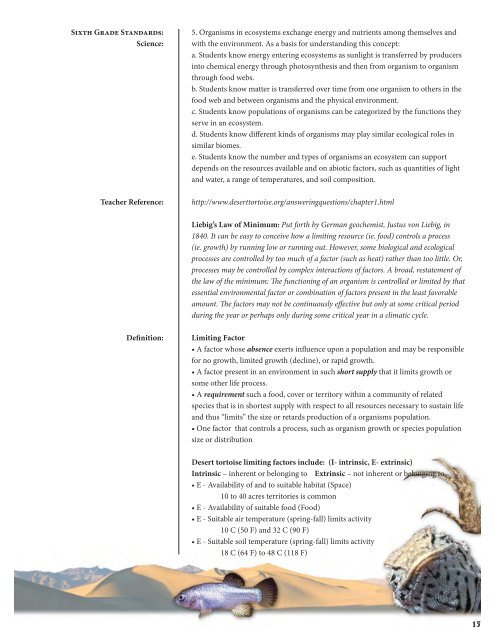5th & 6th Grade Acitivity Curriculum Guide - Needs & Threats to the ...
5th & 6th Grade Acitivity Curriculum Guide - Needs & Threats to the ...
5th & 6th Grade Acitivity Curriculum Guide - Needs & Threats to the ...
You also want an ePaper? Increase the reach of your titles
YUMPU automatically turns print PDFs into web optimized ePapers that Google loves.
Sixth <strong>Grade</strong> Standards:<br />
Science:<br />
Teacher Reference:<br />
5. Organisms in ecosystems exchange energy and nutrients among <strong>the</strong>mselves and<br />
with <strong>the</strong> environment. As a basis for understanding this concept:<br />
a. Students know energy entering ecosystems as sunlight is transferred by producers<br />
in<strong>to</strong> chemical energy through pho<strong>to</strong>syn<strong>the</strong>sis and <strong>the</strong>n from organism <strong>to</strong> organism<br />
through food webs.<br />
b. Students know matter is transferred over time from one organism <strong>to</strong> o<strong>the</strong>rs in <strong>the</strong><br />
food web and between organisms and <strong>the</strong> physical environment.<br />
c. Students know populations of organisms can be categorized by <strong>the</strong> functions <strong>the</strong>y<br />
serve in an ecosystem.<br />
d. Students know different kinds of organisms may play similar ecological roles in<br />
similar biomes.<br />
e. Students know <strong>the</strong> number and types of organisms an ecosystem can support<br />
depends on <strong>the</strong> resources available and on abiotic fac<strong>to</strong>rs, such as quantities of light<br />
and water, a range of temperatures, and soil composition.<br />
http://www.desert<strong>to</strong>r<strong>to</strong>ise.org/answeringquestions/chapter1.html<br />
Liebig’s Law of Minimum: Put forth by German geochemist, Justus von Liebig, in<br />
1840. It can be easy <strong>to</strong> conceive how a limiting resource (ie. food) controls a process<br />
(ie. growth) by running low or running out. However, some biological and ecological<br />
processes are controlled by <strong>to</strong>o much of a fac<strong>to</strong>r (such as heat) ra<strong>the</strong>r than <strong>to</strong>o little. Or,<br />
processes may be controlled by complex interactions of fac<strong>to</strong>rs. A broad, restatement of<br />
<strong>the</strong> law of <strong>the</strong> minimum: The functioning of an organism is controlled or limited by that<br />
essential environmental fac<strong>to</strong>r or combination of fac<strong>to</strong>rs present in <strong>the</strong> least favorable<br />
amount. The fac<strong>to</strong>rs may not be continuously effective but only at some critical period<br />
during <strong>the</strong> year or perhaps only during some critical year in a climatic cycle.<br />
Definition:<br />
Limiting Fac<strong>to</strong>r<br />
• A fac<strong>to</strong>r whose absence exerts influence upon a population and may be responsible<br />
for no growth, limited growth (decline), or rapid growth.<br />
• A fac<strong>to</strong>r present in an environment in such short supply that it limits growth or<br />
some o<strong>the</strong>r life process.<br />
• A requirement such a food, cover or terri<strong>to</strong>ry within a community of related<br />
species that is in shortest supply with respect <strong>to</strong> all resources necessary <strong>to</strong> sustain life<br />
and thus “limits” <strong>the</strong> size or retards production of a organisms population.<br />
• One fac<strong>to</strong>r that controls a process, such as organism growth or species population<br />
size or distribution<br />
Desert <strong>to</strong>r<strong>to</strong>ise limiting fac<strong>to</strong>rs include: (I- intrinsic, E- extrinsic)<br />
Intrinsic – inherent or belonging <strong>to</strong> Extrinsic – not inherent or belonging <strong>to</strong><br />
• E - Availability of and <strong>to</strong> suitable habitat (Space)<br />
10 <strong>to</strong> 40 acres terri<strong>to</strong>ries is common<br />
• E - Availability of suitable food (Food)<br />
• E - Suitable air temperature (spring-fall) limits activity<br />
10 C (50 F) and 32 C (90 F)<br />
• E - Suitable soil temperature (spring-fall) limits activity<br />
18 C (64 F) <strong>to</strong> 48 C (118 F)<br />
15 17

















